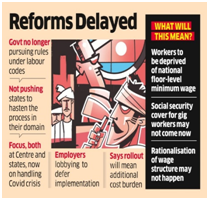

Context
Mahatma Gandhi’s vision of India with no social divides existing in the country remained a thought as after 75 years of Independence there are several issues arouse due to social inequality in the country. Labour reforms are one among the such issue.
Background
- In 2020, there were around 501 million workers in India, the second largest after Out of which, the agriculture industry consists for 41.19%, industry sector consists of 26.18% and the service sector consists of 32.33% of total labour force.
- The Labour force in Indiacan be dividedinto organised and unorganised sectors. The major socio-economic problem of India is that the majority of its citizens are struggling to earn a good living.
- It is not just employment that causes their problems, but the poor quality of that employment: insufficient and uncertain incomes, and poor working conditions, regardless of where they work.
Analysis
What are the present norms for labours in India?
Constitutional Framework:
- Under the Constitution of India, Labour as a subject is in the Concurrent List and, therefore, both the Central and the State governments are competent to enact legislations subject to certain matters being reserved for the Centre.
- Article 14: It provides for equality before the law or equal protection of the laws within the territory of India.
- Article 16: It talks about the right of equal opportunity in the matters of public employment.
- Article 39(c): It specifies that the economic system should not result in the concentration of wealth and means of production to the detriment of the entire society.
Judicial Interpretation:
- In the case of Randhir Singh vs Union of India, the Supreme Court stated that even though the principle of ‘Equal pay for Equal work’ is not defined in the Constitution of India, it is a goal which is to be achieved through Article 14,16 and 39 (c) of the Constitution of India.
Legislative framework: There have been several legislative and administrative initiatives taken by the government to improve working conditions and simplify labour laws. The most recent is the consolidated sets of 4 labour codes which are yet to be implemented.
- Code of Wages, 2019
- Industrial Relations Code, 2020
- Social Security Code, 2020
- Occupational Safety, Health and Working Conditions Code, 2020
- The implementation process is delayed as states are yet to finalise their rules under these codes.
What were the reforms introduced by the Government?
- The new codes have thrown light on the role of an "Inspector-cum-Facilitator" who has the responsibility of checking for compliance as well as facilitating businesses in achieving that compliance.
- The "facilitator" role seems to be a new element and this role could clash with the traditional responsibilities of an "inspector".
- This would enable companies to introduce arbitrary service conditions for their workers.
Do they justify the demands of Labours in India?
- Left-Out Gig workers
- Small Start-ups and Informal Sector Left-out From Social Security Coverage
- Migrant workers, self-employed workers, home-based workers, and other vulnerable groups in rural areas are not covered under social security benefits.
- Non-Inclusion of Charitable or Non-Profit Based Establishments

|
Who are Invisible workers? Invisible labour is the part that goes unnoticed and unrecognised and is thus unregulated. Generally, unpaid work is called Invisible labour. |
What can be the possible Implications?
|
Pros |
Cons |
|
|
Required measures
- Vocational Training: There is a need to develop a framework to interlink vocational training and academic education in order to facilitate the inter-stream movement of students and vocational trainees.
- Social Security: There is also a need for welfare services for unorganised workers such as compensation for accidents at work, death, and old age pension in the ‘risk cover mode’.
- Employment Information Service: To support the new initiatives to provide employment guarantees in backward districts, employment information services need to be provided through e-governance.
- Integrating Problem Solving with Forward Looking Approach: Most of the provisions of the Codes address the past demands and discrepancies, acting as restorative justice for the past harms.
Conclusion
It is essential that we should adopt a futuristic approach when it comes to protecting workers and handling disputes regarding Automation and Robotics, AI-powered workforces, and bioengineering, which may hamper workers' rights in the future.

